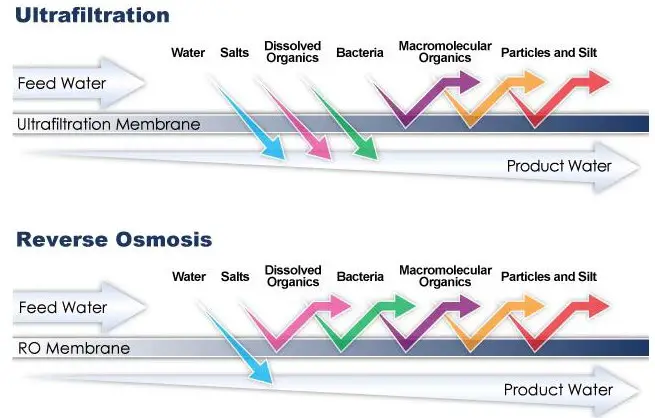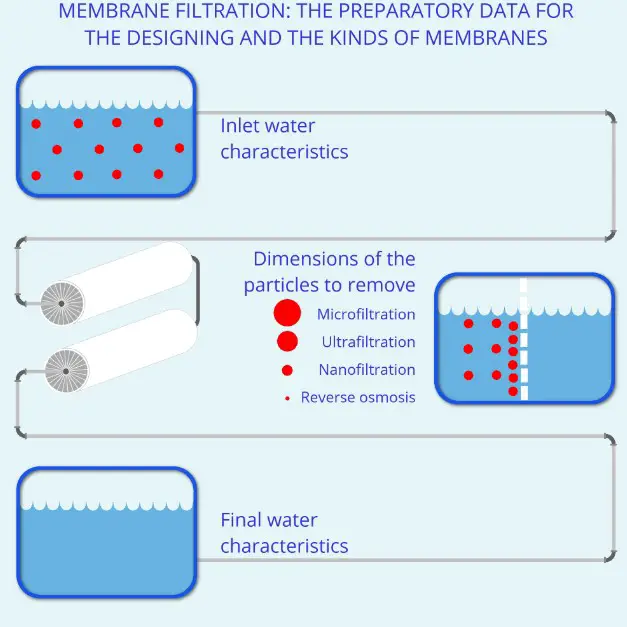In the realm of water purification technologies, two methods stand out for their effectiveness and widespread application: ultrafiltration and reverse osmosis. These processes play crucial roles in providing clean, safe water, a fundamental need for households, industries, and municipalities worldwide. By leveraging different principles and mechanisms, each technology addresses specific contaminants and quality concerns, highlighting the importance of understanding their differences and applications.
Ultrafiltration and reverse osmosis are both processes used to purify water, but they operate on distinct principles and are suited to different types of contaminants. Ultrafiltration uses a semi-permeable membrane to separate particles and substances based on size, effectively removing bacteria, viruses, and larger particles. Reverse osmosis, on the other hand, forces water through a semi-permeable membrane at high pressure, removing a broader range of contaminants, including dissolved salts, lead, and other chemicals.
The significance of these technologies extends beyond providing access to potable water. They are integral to various industrial processes, waste management, and environmental conservation efforts. Ultrafiltration and reverse osmosis not only ensure the safety and quality of drinking water but also play a vital role in the sustainability and efficiency of water usage across different sectors. By understanding the specific capabilities and limitations of each method, users can make informed decisions about water treatment solutions that best meet their needs.

Water Purification Basics
Key Processes
Water purification encompasses a variety of processes aimed at removing unwanted substances from water to make it safe for drinking and other uses. The key processes include:
- Filtration: This involves passing water through filters to remove particles and sediments.
- Sedimentation: Larger particles are allowed to settle to the bottom of a container for easy removal.
- Disinfection: Chemicals or physical processes are used to kill bacteria and viruses in the water.
- Distillation: Water is boiled, and the steam is collected, leaving most types of impurities behind.
- Reverse Osmosis (RO): Water is forced through a semi-permeable membrane to remove a wide range of contaminants.
- Ultrafiltration (UF): Similar to RO but uses slightly larger pores, making it effective for different types of contaminants.
Importance of Clean Water
Clean water is essential for health and environmental sustainability.
- Health aspects: Drinking contaminated water can lead to diseases such as cholera, dysentery, and typhoid. Clean water is crucial for hydration, cooking, and personal hygiene, directly impacting public health.
- Environmental aspects: Purified water means less strain on natural ecosystems. Properly treated wastewater can be reused, reducing the need for fresh water extraction from rivers and aquifers.
Ultrafiltration Explained
Definition and Process
Ultrafiltration is a type of membrane filtration where water is forced through a membrane with pores small enough to remove various contaminants, including bacteria, viruses, and certain large molecules.
How Ultrafiltration Works
- Water is passed through a semi-permeable membrane.
- The membrane’s pores are small enough to block particles and pathogens but large enough to allow water molecules to pass through.
- Contaminants are retained on the membrane surface and later removed.
Applications
Ultrafiltration is used in:
- Drinking water purification
- Wastewater treatment
- Food and beverage industry
- Pharmaceutical manufacturing
Advantages
The key benefits of ultrafiltration include:
- Effective removal of bacteria and viruses
- Low energy requirements compared to reverse osmosis
- No need for chemicals in the filtration process
Limitations
Challenges with ultrafiltration involve:
- Less effective against dissolved salts and small molecules
- Membranes can become clogged, requiring regular cleaning or replacement
Reverse Osmosis Overview
Definition and Mechanism
Reverse osmosis is a water purification process that removes contaminants from water by forcing it through a semi-permeable membrane under pressure. This allows pure water to pass through while leaving behind salts, minerals, and other impurities.
Understanding Reverse Osmosis
- A high-pressure pump pushes water across the RO membrane.
- Contaminants larger than water molecules are filtered out.
- The purified water is collected for use.
Applications
Reverse osmosis is utilized in:
- Desalination plants for converting seawater into drinking water
- Municipal water treatment
- Industrial processes requiring high-purity water
- Home water purification systems
Advantages
Benefits of reverse osmosis include:
- Highly effective at removing a wide range of contaminants, including dissolved salts and heavy metals
- Produces high-quality, safe drinking water
- Energy-efficient compared to distillation
Limitations
The downsides of reverse osmosis involve:
- Requires significant pressure, increasing energy costs
- Wastewater production, as contaminants are flushed away
- Possible removal of beneficial minerals from the water

Ultrafiltration Vs. Reverse Osmosis
Water purification technologies have evolved significantly, offering diverse solutions to meet various quality standards and needs. Two prominent methods, ultrafiltration (UF) and reverse osmosis (RO), are widely recognized for their efficacy. However, their differences in process, effectiveness, cost, and maintenance requirements necessitate a deeper understanding to make informed decisions for specific applications.
Process Differences
Comparing the Filtration Processes
Ultrafiltration employs a semi-permeable membrane to separate substances based on size. It effectively removes particles, pathogens, and some macromolecules from water, making it suitable for eliminating bacteria and viruses without the need for high pressure or energy.
Reverse osmosis, in contrast, requires water to be pushed through a semi-permeable membrane at high pressure, filtering out a broader range of contaminants, including dissolved salts, minerals, and organic compounds. This process yields a higher purity level, making it ideal for applications requiring demineralized water.
Efficiency and Effectiveness
Which is More Effective for Specific Contaminants
The choice between UF and RO often depends on the specific contaminants present in the water source. Ultrafiltration is highly effective against microorganisms and large particles but less so against dissolved ions and small molecules. It is preferred when the primary concern is microbial contamination.
Reverse osmosis excels in removing dissolved substances, including salts and small organic compounds, offering comprehensive purification. It is the go-to option for desalinating water or reducing mineral content.
Cost Comparison
Analyzing the Economic Aspects
When considering the cost of water purification systems, initial investment and operational expenses come into play. Generally, ultrafiltration systems are less expensive to install and operate, owing to their lower energy requirements and simpler mechanism.
Reverse osmosis systems, while more costly upfront and in terms of energy consumption, provide a higher purification level. The increased cost can be justified for applications demanding the highest water purity, such as in pharmaceutical manufacturing or potable water production from saline sources.
Maintenance and Durability
Understanding Upkeep Requirements
The maintenance of UF and RO systems involves regular cleaning and periodic membrane replacement. Ultrafiltration membranes typically have a longer lifespan due to the lower operating pressures, resulting in less wear and tear. However, they may require more frequent cleaning if used in waters with high sediment or organic matter.
Reverse osmosis membranes are subjected to higher pressures, which can accelerate wear. Despite this, RO systems are designed for efficiency and longevity, with membranes that can last several years with proper care, including pre-treatment of feed water to remove particles that could clog the membrane.
Selecting The Right Technology
Choosing between UF and RO involves considering various factors, including the specific water quality requirements, cost implications, and maintenance capabilities.
Factors to Consider
- Contaminant profile: Understanding the types and concentrations of contaminants present in the water source is crucial.
- Water quality goals: Consider whether the priority is to remove microorganisms, reduce TDS (total dissolved solids), or both.
- Budget constraints: Evaluate both the initial setup costs and long-term operational expenses.
- Maintenance resources: Assess the availability of technical expertise and resources for system maintenance.
Case Studies
Real-world applications provide valuable insights into decision-making processes:
- Municipal Drinking Water: Many cities use RO to ensure the removal of a broad range of contaminants, including pharmaceuticals and microplastics.
- Breweries: Breweries often prefer UF for filtering water used in beer production, as it effectively removes particulates and microorganisms while preserving essential minerals.
Future Trends
The ongoing development in water purification technology promises more efficient, sustainable, and cost-effective solutions.
Technological Advancements
Innovations in membrane materials and design are enhancing the efficiency and lifespan of UF and RO systems. New technologies aim to reduce energy consumption and increase the recovery rate of purified water, making these systems more environmentally friendly and economically viable.
Environmental Impact
Sustainability considerations are driving research and development in water purification. Advances in UF and RO technologies are focused on minimizing waste and energy use. Efforts to recycle or repurpose wastewater from RO systems and innovations in low-energy membrane materials for UF are examples of how the industry is addressing environmental concerns.
Frequently Asked Questions
What is Ultrafiltration?
Ultrafiltration is a type of membrane filtration where water is forced through a semi-permeable membrane, trapping particles, bacteria, viruses, and other pathogens larger than the membrane’s pore size. This process is highly effective for removing macromolecules and larger contaminants from water, making it suitable for applications requiring high purity levels.
How does Reverse Osmosis work?
Reverse osmosis involves applying pressure to water, forcing it through a semi-permeable membrane that removes dissolved ions, unwanted molecules, and larger particles. This process is widely used for desalination, removing fluoride, chlorine, and other dissolved chemicals, making it integral to producing drinking water from saline sources.
Can Ultrafiltration remove viruses?
Yes, ultrafiltration can effectively remove viruses from water. The process uses membranes with pore sizes small enough to block viruses, typically around 0.01 to 0.1 micrometers, making it an effective barrier against pathogenic microorganisms and ensuring the production of microbiologically safe water.
Is Reverse Osmosis water healthy?
Reverse osmosis water is considered healthy as it removes contaminants, including bacteria, viruses, heavy metals, and chemical pollutants, ensuring the water is safe for consumption. However, it also removes some beneficial minerals, so it’s recommended to use mineralization filters or consume mineral-rich foods to maintain a balanced mineral intake.
Difference between Ultrafiltration and Reverse Osmosis efficiency?
The efficiency of ultrafiltration and reverse osmosis varies based on the contaminants being removed. Ultrafiltration is highly effective for removing bacteria, viruses, and particulates but less so for dissolved salts and small molecules. Reverse osmosis excels at removing a broader range of contaminants, including dissolved salts, heavy metals, and microorganisms, making it more efficient for comprehensive water purification.
Conclusion
Choosing between ultrafiltration and reverse osmosis depends on the specific needs and goals of water purification. Each technology offers unique benefits and limitations, making them suitable for different applications. Ultrafiltration is ideal for removing larger pathogens and particles, while reverse osmosis provides a more thorough purification, eliminating dissolved salts and smaller molecules. Understanding these differences allows individuals and industries to select the most appropriate water treatment method, ensuring the safety, quality, and sustainability of water resources.
In conclusion, the advancements in water purification technologies like ultrafiltration and reverse osmosis signify a leap towards securing clean, safe, and accessible water for all. As we continue to face global challenges related to water scarcity and pollution, these technologies play a pivotal role in conservation efforts and sustainable water management practices. By making informed decisions based on the properties and applications of each method, we can ensure the well-being of our communities and the environment.

